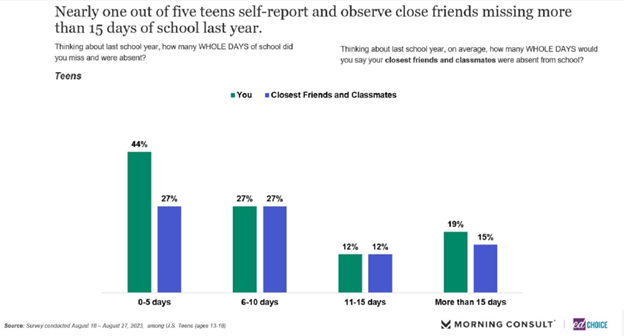Many unique happenings have occurred since the Covid-19 pandemic. One of the more negative ones is chronic absenteeism in the schools.
A study released in fall 2023 by EdChoice found that nationwide “nearly 1 in 5 teens reported missing more than 15 whole days of school during the previous school year.”

Attendance rates aren’t that great in Minnesota either. Only a few weeks ago, WCCO reported on numbers from the Minnesota Department of Education showing that “only 70% of students attended class at least 90% of the time during the 2021-2022 school year…. Pre-pandemic, those numbers were closer to 85%.”
This is a serious problem, the article noted, for “research shows middle schoolers who miss more than two weeks of class a year have only a 66% chance of graduating high school.”
So why are students—especially those in Minnesota—missing so much school? Three reasons come to mind.
The first is the emphasis placed on e-learning during the pandemic. Minneapolis Public Schools Director of Student Retention Colleen Kaibel mentioned this fact to WCCO, noting, “I think for the student who has found ‘I can do this without being in the classroom’, that is definitely contributed [sic] to a lack of attendance.”
She makes a great point. Perhaps school districts and teachers’ union presidents such as Randi Weingarten did such a great job convincing people that Covid-19 made it impossible for them to re-open schools, that students believed them, too. If school wasn’t a priority a few years ago for teachers and the adults responsible for the education of the nation’s students, then how can we expect students to treat it like a priority today?
Kids aren’t dumb. They know when you’re reversing course mid-stream, but they’ll hold you to something you said if they think it benefits them. Perhaps it’s going to take school officials humbly admitting they were wrong on the e-learning policies of recent years before students will begin to ditch chronic absenteeism.
A second reason is the massive size of public schools these days. As we’ve noted before, there were around 8,000 school districts in Minnesota around the turn of the 20th century. Today there are only 331 districts, which means that students are far-flung and more likely to be stuffed in huge schools where they get lost in the shuffle. When that is the case, students can easily feel they don’t matter … so why bother to show up?
Finally, consider the chaos that seems so prevalent in today’s schools. This fall was full of reports of fights at schools in cities around the state, including White Bear Lake, St. Cloud, and Brooklyn Park. Add the confusion and tension over School Resource Officers and the procedures they could follow to handle unruly students, and it’s clear that the learning environment at many schools is far from enjoyable. Who can blame kids if they’re afraid to go to school or feel it’s no use to attend if everything’s often out of control?
Perhaps it’s problems like these that are causing so many states to consider school choice. School choice, for example, offers students the opportunity to get into a smaller school, which makes the student feel an increased sense of belonging. Students don’t get lost in the crowd as easily, and they won’t want to miss school or try to hide behind e-learning as much for fear they’ll miss out on the action in their school family.
Chances are, a smaller school will also have a less chaotic environment as teachers and administrators can cultivate relationships with students, which will in turn disincentivize behavior issues. But of course, if there are behavior issues that parents are uncomfortable with, school choice—and particularly Education Savings Accounts (ESAs)—makes it much easier for parents to choose a new school if needed.
Chronic absenteeism is a problem—there’s no denying it. But the solution might be easier than we think if we just think outside the box and implement ESAs in the state of Minnesota.
—
Image Credit: Rawpixel











![[downloaded during free trial]](https://oakmn.org/wp-content/uploads/2025/11/iStock-1430368205-120x86.jpg)

